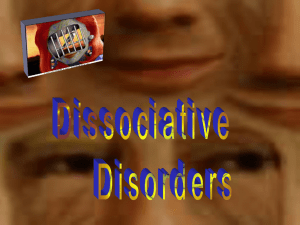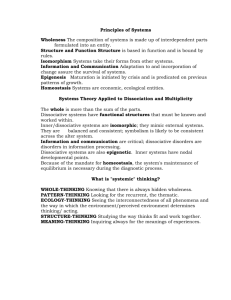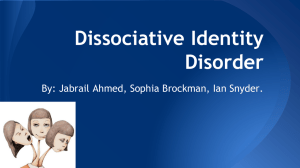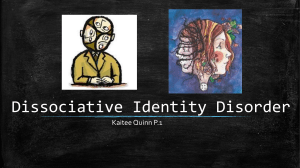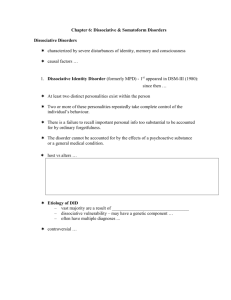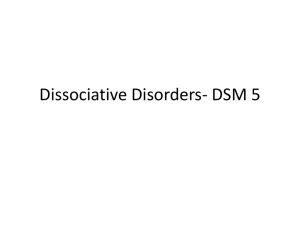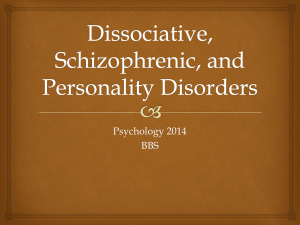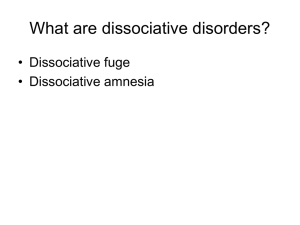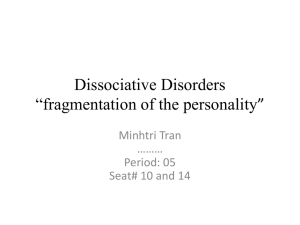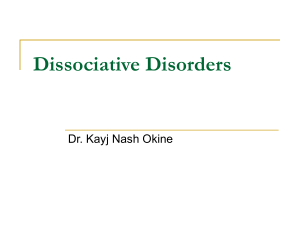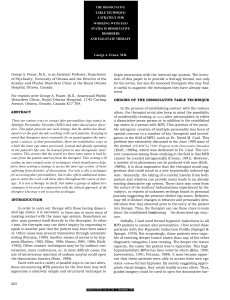Dissociative Disorders
advertisement
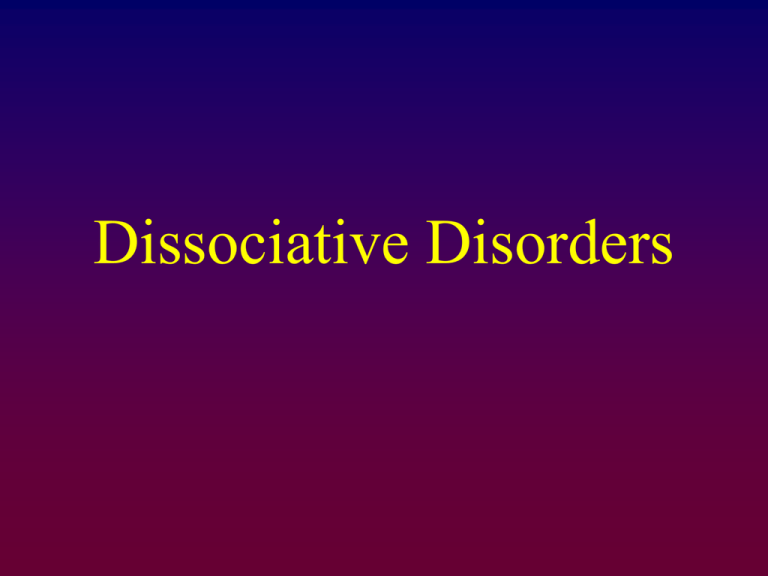
Dissociative Disorders Dissociative Disorders • A category of psychological disorders in which extreme and frequent disruptions of awareness, memory, and personal identity impair the ability to function • What is dissociation? – literally a dis-association of memory – person suddenly becomes unaware of some aspect of their identity or history – unable to recall except under special circumstances (e.g., hypnosis) • Mild dissociative experiences are quite common and completely normal (daydreaming, TV Face) Dissociative Amnesia • Memory loss the only symptom • Partial or total inability to recall important personal information. • Often selective loss surrounding traumatic events – person still knows identity and most of their past • Can also be global – loss of identity without replacement with a new one • Memory can return just as suddenly as it was lost. • Not caused by a biological problem. It is psychological. Dissociative Amnesia Example • Margie and her brother were recently victims of a robbery. Margie was not injured, but her brother was killed when he resisted the robbers. Margie was unable to recall any details from the time of the accident until four days later. Dissociative Fugue • Forgetting personal info and past events while suddenly relocating and taking on a new identity. Almost always after a traumatic event. – – – – leaves home develops a new identity apparently no recollection of former life called a ‘fugue state’ • If fugue wears off – old identity recovers – new identity is totally forgotten Dissociative Fugue Example • Jay, a high school physics teacher in New York City, disappeared three days after his wife unexpectedly left him for another man. Six months later, he was discovered tending bar in Miami Beach. Calling himself Martin, he claimed to have no recollection of his past life and insisted that he had never been married. Dissociative Identity Disorder • Originally known as “multiple personality disorder” • 2 or more distinct personalities within the same person • Personalities may or may not know the other exists • VERY rare and controversial disorder • Examples include Sybil, Trudy Chase, Chris Sizemore (“Eve”) • Has been tried as a criminal defense but is rarely successful. (see the movie, Primal Fear) Dissociative Identity Disorder • Pattern typically starts prior to age 10 (childhood) • Most people with disorder are women • Most report recall of physical or sexual abuse as children and show symptoms of PTSD Dissociative Identity Disorder (DID) Example Norma has frequent memory gaps and cannot account for her whereabouts during certain periods of time. While being interviewed by a clinical psychologist, she began speaking in a childlike voice. She claimed that her name was Donna and that she was only six years old. Moments later, she seemed to revert to her adult voice and had no recollection of speaking in a childlike voice or claiming that her name was Donna. DID Facts • Alternate personalities, often called alters, may be of widely varying ages and of different genders. • Alters are not really separate people; rather, they constitute a “system of mind.” At different times, different alters take over. Person’s primary personality often not aware of the alters. • Some researchers report physiological differences among the different personalities within a single individual (different allergies & eyeglass prescriptions). • Symptoms of amnesia and memory problems are almost always present. People with DID typically have numerous other psychiatric and physical problems along with a chaotic personal history. Multiple Personality Disorder Tony describes his life with multiple personalities, some of which we see emerging in a therapy session. Dr. Frank Putnam, at the National Institute of Mental Health, describes the results of testing on Tony and other individuals with multiple personality disorder. •Click HERE to view or on the box to the right (8 min) •Watch shorter version see Tony go between his alters (4 min). •Hear the story of Herschel Walker (3 min). Depersonalization Disorder “Out of Body Experience” • Depersonalization – person feels as if they are outside their bodies, observing themselves from a distance. • Usually happens after a stressful event. Possible Causes of Dissociative Disorders • Psychoanalytic Theory – people dissociate to repress unacceptable urges. – People forget disturbing urges or develop personalities to take responsibility away from themselves. • Learning Theory – Forgetting or being someone else is negatively reinforced because it reduces stress. • Cognitive & Biological Theorists do NOT have an explanation for dissociative disorders.
